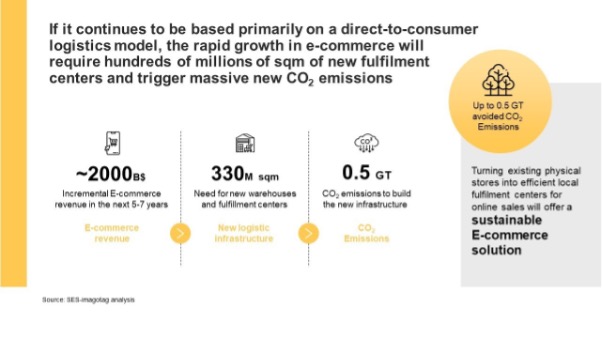Thierry Gadou, CEO SES-imagotag
- Retail is the largest private employer and economic sector, comprising over 15% of the global GDP.
- Growth in e-commerce requires new infrastructure, which contributes to massive carbon emissions.
- Utilising existing physical stores to fulfil online sales locally could offer a sustainable solution.
I find it surprising that retail is relatively absent from the core debate on net-zero even though it’s the largest economic sector and private employer in the world, with over 15% of global GDP and jobs1.
Greenhouse gas (GHG) emissions are usually broken down into energy, transportation, building, manufacturing, agriculture and so on, but retail is absent. Yet retail is one of the largest ordering customers of many of these sectors, and retail supply chains are responsible for 25% of global GHG emissions2, according to the World Business Council for Sustainable Development. Clearly, the decarbonization of retail should be a central topic in the climate emergency discussion.
Moreover, the current evolution of retail is accelerating carbon emissions due to the unstoppable shift from physical stores to online platforms. As e-commerce continues to grow at 10-20% annually3, so far primarily based on a direct-to-consumer (DTC) logistics model, a completely new and dedicated supply chain infrastructure is gradually being built with thousands of warehouses and automated fulfilment centres.
Growth in e-commerce and carbon emissions
E-commerce DTC logistics requires about 1 million square metres of fulfilment centres for $6 billion of revenues. The construction of new physical infrastructure (land artificialization, concrete, steel, robotics, etc.) drives massive carbon emissions in the order of 1-1.5 tons per square metres4. Construction-related emissions are often overlooked or depreciated over 50 years (lifespan of buildings), but this is a biased way of accounting and discounting carbon impact because, from a climate perspective, 100% of carbon emissions are in the atmosphere at the time of construction.
Experts anticipate that e-commerce will continue to grow at 10-20% annually and should represent 30-40% of total retail sales in 5-7 years5. That means adding over $2 trillion of e-commerce revenues. If this growth was primarily based on a DTC model, this would imply emissions of up to 0.5 giga tons of CO2 equivalent, just for the construction of the necessary supply network, not taking into account the additional inventories required by this dedicated e-commerce supply chain nor the operational and last-mile related carbon emissions.
The development of e-commerce over the next 5-10 years could lead to a massive increase in carbon emissions, counteracting the net-zero trajectory due to a flawed model based on the shift from offline to online. And nobody talks about it.
Harnessing existing physical infrastructure
Fortunately, a more sustainable retail development model exists based on revitalising the existing physical infrastructure of commerce.
There are approximately 20 million stores worldwide – one store for 400 humans – served by an existing supply chain which every day brings all consumer goods no further than a few miles away from any consumer.
This incredible density of stores – and proximity of goods for consumers – is the obvious solution to a low- carbon e-commerce model. This will not only avoid massive carbon emissions but will dramatically increase customer satisfaction. Tomorrow, consumers will order more and more online, but they will be delivered in less than an hour from a shop around the corner. This is what I call “physical e-commerce” of “local e-commerce”.
Of course, technology is necessary for this transformation. Revitalizing the “stranded” assets of physical commerce, and stores, and enabling local e-commerce at scale requires the following:
- Turn physical stores into ultra-efficient local fulfilment centres of online orders. Enabled by IoT, cloud, big data and AI/AR technologies, enabling precise product geolocation in-store, efficient picking and replenishing processes, real-time monitoring of on-shelf inventory and stock-outs, etc.
- Virtualize the aggregated stores’ inventories to identify in real-time the nearest stores and product availability for every online order. This will allow for minimising the time of delivery and carbon emissions.
Tech-enabled stores offer a sustainable solution
Already, several visionary retailers are pioneering sustainable and positive retail models. For example, Walmart is putting stores at the heart of its e-commerce strategy, with plans to deliver most online orders out of physical stores. Ikea is another inspiring retailer going “phygital” by including stores in their last-mile and fulfilment network so that shipping online orders from out-of-town stores means faster deliveries and lower emissions than shipping from logistics centres.
These pioneers show that it is possible, by revitalizing the existing infrastructure of physical commerce, to build a low-carbon and sustainable retail model. In the future existing stores could deliver over 50% of total e-commerce sales, thus avoiding giga tons of otherwise inevitable carbon emissions.
Beyond avoiding massive unnecessary GHG emissions, such a “phygital” (or unified) retail development model would have other positive social and environmental consequences:
- Protecting local jobs and communities by stemming the tide of stores closings, thus avoiding the risk of massive employment destruction in physical retail due to online/offline substitution.
- Fostering local-for-local production and consumption models.
That’s why in many respects, the technologies enabling the digitization of physical retail can be considered as climate technologies, as they can significantly contribute to the net-zero imperative.
Time is of the essence. The digitization of physical commerce is an economic, social, and environmental imperative. Each delay in this transition favours the rapid development of a highly carbon-intensive direct- to-consumer e-commerce model. Visionary retailers are showing the path towards a more sustainable and socially positive retail model. Helping this transition requires decision makers, public and tax policymakers and investors to understand the tremendous opportunity of creating positive shared value for consumers, workers, and the planet by revitalizing physical stores through technology.
It’s with this profound belief and sense of purpose and responsibility that, together with Peter Brabeck- Letmathe, Vice-Chairman of the Board of Trustees of the World Economic Forum and former CEO of Nestlé, we have created the International Board for Retail Sustainability, Transparency and Consumer Protection and have launched the Positive Retail Research Program.
1 https://www.kearney.com/global-retail-development- index/2021#:~:text=Retail%20sales%20account%20for%20 12,employment%E2%80%94about%201.2%20million%20people. 2 https://timetotransform.biz/
3 https://www.mckinsey.com/~/media/McKinsey/Industries/Retail/ Our%20Insights/retail%20speaks%20seven%20imperatives%20for%20the%20 industry/retail-speaks-full-report.pdf
4 https://resources.taloen.fr/resources/documents/7765_191210_ poids_carbone_ACV_vdef.pdf
5 https://www.mckinsey.com/~/media/McKinsey/Industries/Retail/ Our%20Insights/retail%20speaks%20seven%20imperatives%20for%20the%20 industry/retail-speaks-full-report.pdf

Graduate of the Mines de Paris engineering school, Thierry Gadou is the Chairman & CEO of SES-Imagotag since 2012. Thierry began his career as a management consultant at international consulting firm Deloitte, where he was a partner from 1997 to 2000. He then co-founded and was the CEO of Hubwoo, a high-tech company listed on the Euronext Paris stock exchange which became one of the world’s leading SAP-based electronic marketplaces specializing in e-procurement solutions for large companies.
From 2007 to 2012, Thierry has been the CEO of Atos Consulting, the management consulting division of Atos. Since 2012, as the Chairman & CEO, he has transformed SES-imagotag into the largest and fastest- growing retail IoT company, serving over 350 among the largest retailers groups in more than 60 countries.
SES-imagotag is a proud supporter of the United Nations’ Global Compact initiative, a member of the World Economic Forum’s future of consumption platform, and has received in 2022 the Platinum Sustainability Rating from EcoVadis, the world’s reference of business sustainability ratings.





